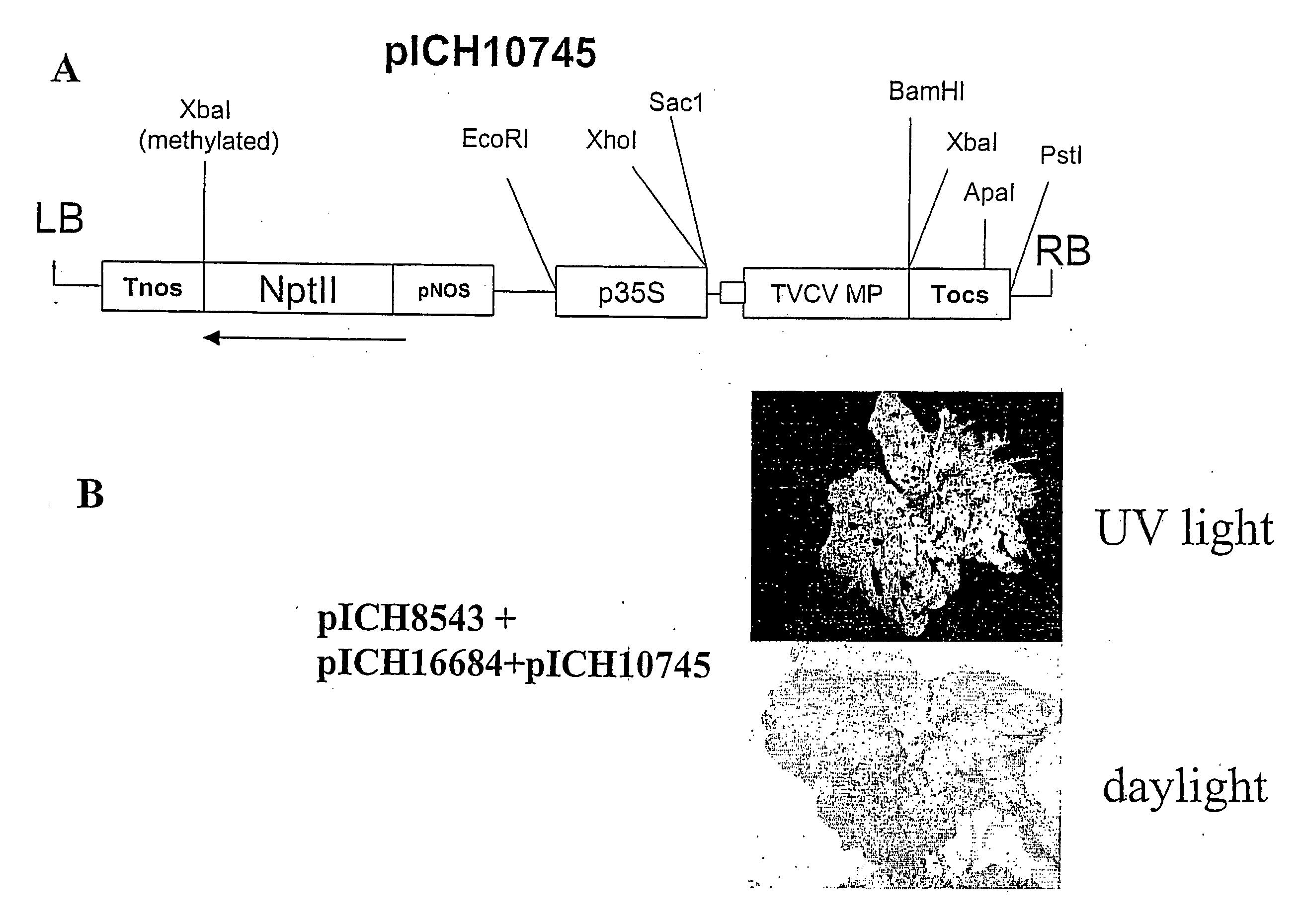Two-Component Rna Virus-Derived Plant Expression System
a plant and rna virus technology, applied in the field of rna virus-derived plant expression system, can solve the problems of limited capacity with regard to the size of dna to be amplified, system is hardly competitive with other expression systems, and the use of such an approach is limited, so as to minimize the risk of wild type virus reconstruction, improve the efficiency of rna replicon, and improve the effect of rna replicon efficiency
- Summary
- Abstract
- Description
- Claims
- Application Information
AI Technical Summary
Benefits of technology
Problems solved by technology
Method used
Image
Examples
example 1
Construction of a GFP-Expressing TMV-Based RNA Vector
[0135] A cr-TMV-based viral vector containing GFP, pICH8543 (FIG. 1), has been described in international patent application PCT / EP03 / 12530 (see also below). This clone contains the Arabidopsis Actin2 promoter, the TVCV RNA-dependent RNA polymerase, a chimaeric sequence (TVCV / cr-TMV) for the movement protein, the GFP coding sequence, the 3′ untranslated region of cr-TMV and finally the Nos terminator, cloned in a binary vector. This clone lacks a coat protein coding sequence. pICH8543 was transformed into Agrobacterium strain GV3101 and infiltrated into one leaf of a Nicotiana benthamiana plant using a needle-less syringe. Four days after infiltration, GFP fluorescence foci could be seen in the infiltrated area. Fluorescence lasted for several weeks in the infiltrated leaf but did not move to upper uninoculated leaves.
Construction of Vector pICH8543
[0136] A replicon containing a green fluorescence protein (GFP) gene was made i...
example 2
Construction of a CP-Expressing TMV-Based RNA Vector
[0137] Cloned cDNAs of the crucifer-infecting tobamovirus (cr-TMV; Dorokhov et al., 1994, FEBS Lett. 350, 5-8) and of the turnip vein-clearing virus (TVCV; Lartey et al., 1994, Arch. Virol. 138, 287-298) were obtained from Prof. Atabekov from Moscow University, Russia. A viral vector expressing TVCV CP was made by subcloning an EcoRI-ApaI fragment (containing part of MP, the complete CP coding sequence, and the 3′ non translated region of TVCV) from the TVCV cDNA into pICH8543. The resulting clone, pICH10595 (FIG. 1), contains the complete TVCV cDNA cloned between the Arabidopsis Actin2 promoter and the Nos terminator, in a binary vector. The pICH10595 was transformed in Agrobacterium strain GV3101 and infiltrated into a Nicotiana benthamiana leaf. Three weeks later, the upper non-infiltrated leaves had a wrinkled yellow appearance indicating viral infection. Polyacrylamide gel electrophoresis (PAGE) with coomassie staining and We...
example 3
Construction of a CP-Expressing Clone Lacking an Origin of Assembly
[0139] In the previous example, only the wild type virus is detected in the upper uninoculated leaves when the lower leaves are first infiltrated with a mixture of CP and GFP-expressing clones. The CP clone is so efficient to replicate and move that the GFP-expressing clone cannot compete effectively and move systemically. To prevent the CP-expressing clone to move systemically, we removed the area that putatively contains the origin of assembly (OAS) of the virus (the CP-expressing clone), which corresponds to part of the MP located upstream of the CP subgenomic promoter. The resulting clone, pICH16601 (FIG. 1) is similar to pICH10595 but lacks base pairs 4966-5454 (coordinates relative to GenBank accession BRU03387). pICH16601 was transformed in Agrobacterium strain GV3101 and was coinfiltrated with pICH8543 into a Nicotiana benthamiana leaf. Twelve days later, GFP fluorescence appeared in the veins of the upper n...
PUM
| Property | Measurement | Unit |
|---|---|---|
| Fraction | aaaaa | aaaaa |
| Digital information | aaaaa | aaaaa |
| Frequency | aaaaa | aaaaa |
Abstract
Description
Claims
Application Information
 Login to View More
Login to View More - R&D
- Intellectual Property
- Life Sciences
- Materials
- Tech Scout
- Unparalleled Data Quality
- Higher Quality Content
- 60% Fewer Hallucinations
Browse by: Latest US Patents, China's latest patents, Technical Efficacy Thesaurus, Application Domain, Technology Topic, Popular Technical Reports.
© 2025 PatSnap. All rights reserved.Legal|Privacy policy|Modern Slavery Act Transparency Statement|Sitemap|About US| Contact US: help@patsnap.com



